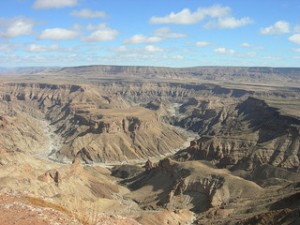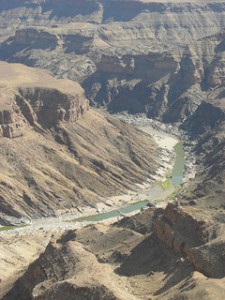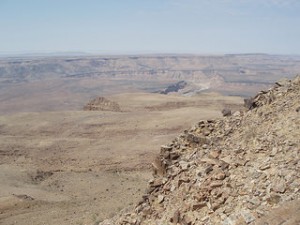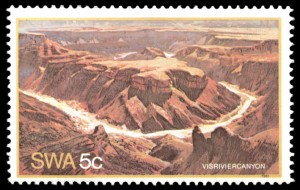Namibia is purported to have some of the most beautiful postage stamps in the world. But what’s more fascinating are the stories behind the artful images they depict—plant and animal life, traditional cultures, history and landmark events. Many people are unfamiliar with Namibia—until they visit on our motorcycle safaris and fall in love with it.
This month we’re inspired by the stamp that honors Fish River Canyon.
Legend of the Fish River Canyon
“Once upon a time a giant snake dwelled in southern Namibia. Every so often it devoured the people’s sheep and goats and so finally they decided to kill the snake. Armed with spears and accompanied by their dogs the men set out for the hunt. They encircled the snake, keeping it at bay with fiery torches, shooting arrows at it and thrusting spears into its body. Even though it was a giant snake it stood no chance against their superior numbers. In its death throes the snake tossed and turned, tearing deep furrows into the ground.
This old Nama legend explains in this vivid manner how the Fish River Canyon was formed.”[1]

Geologists have a slightly different version. They tell us that about 500 million years ago, the earth caved in along ancient fissures in its crust, creating a 20 km wide rift valley. Glaciers moving south later deepened the valley and sculpted exposed sediments. Most recently, 50 million years ago the Fish River began to cut its way along the valley floor, meandering between boulders and adding erosion as an influencing force.
However you cut it, Fish Canyon is an awe-inspiring formation and has been drawing visitors for centuries. Jim Niemeyer, who saw it for the first time during his Wildlife and Waterfalls safari made a point of getting his photo taken at the same spot his daughter had posed during her overland adventure 12 years earlier.

Situated in very arid southern Namibia, the canyon is large—about 160 km long, up to 27 km. wide and 550m deep. Depending on how it’s measured, it’s the largest canyon in the southern hemisphere, and second in the world only to Arizona’s Grand Canyon. Fish River is the longest river in Namibia and the only one that usually retains pools of water during the dry season. As a result, it’s been a lifeline for local inhabitants for eons. Archeologists have discovered evidence of people dating back 50,000 years to the early, middle, and late Stone Ages.

Because it’s so dry, flora, fauna, bird, and wildlife sightings are rare, and those that are there are not always obvious. Vegetation is sparse except for lush pockets nourished in deeper sections of the valley. Keep an eye out for black eagles, herons, and kingfishers. Knowing where to look may yield sightings of zebras, kudus, antelope, and baboons.

The viewing points allow you to visually trace the canyon’s formation, whether you’re facing the high plain known as the ‘upper canyon’ or the ‘lower canyon’s meandering gorges and the floor of the rift valley.
A visit to Fish River Canyon is part of the Waterfalls and Wildlife, Victoria Falls to Cape Town, and Spectacular South West Africa Safari Motorcycle Safaris.
Source:
Stamps and Stories, Vol. 1, 50 Stories on Namibia’s Postal Stamps, Gondwana Collection Namibia, & NamPost, 2012
[1] Stamps and Stories, Vol. 1, p.85
Photo credits (in order)
photo credit: Fish River Canyon via photopin (license)
photo credit: Fish River Canyon via photopin (license)
photo credit: P9033391 via photopin (license)
photo credit: Fish River Canyon via photopin (license)


